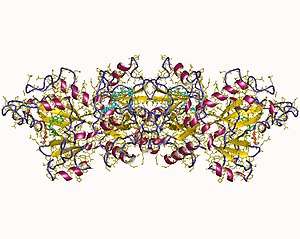Pseudomonas exotoxin

Exotoxin A dimer, Pseudomonas aeruginosa
The Pseudomonas exotoxin (or exotoxin A) is an exotoxin produced by Pseudomonas aeruginosa.[1]
It inhibits elongation factor-2.[2] It does so by ADP-ribosylation of EF2. This then causes the elongation of polypeptides to cease. (The mechanism of the toxin is similar to that of Diphtheria toxin.)
It has been investigated as a treatment for hepatitis B[3] and cancer.[4]
References
- ↑ Yates SP, Taylor PL, Jørgensen R, et al. (February 2005). "Structure-function analysis of water-soluble inhibitors of the catalytic domain of exotoxin A from Pseudomonas aeruginosa". Biochem. J. 385 (Pt 3): 667–75. doi:10.1042/BJ20041480. PMC 1134741. PMID 15458385.
- ↑ Yates SP, Merrill AR (May 2004). "Elucidation of eukaryotic elongation factor-2 contact sites within the catalytic domain of Pseudomonas aeruginosa exotoxin A". Biochem. J. 379 (Pt 3): 563–72. doi:10.1042/BJ20031731. PMC 1224111. PMID 14733615.
- ↑ Hafkemeyer P, Brinkmann U, Brinkmann E, Pastan I, Blum HE, Baumert TF (May 2008). "Pseudomonas exotoxin antisense RNA selectively kills hepatitis B virus infected cells". World J. Gastroenterol. 14 (18): 2810–7. doi:10.3748/wjg.14.2810. PMC 2710720. PMID 18473403.
- ↑ Stuckey, Daniel; Hingtgen, Shawn; Karaka, Nihal; Rich, Benjamin; Shah, Khalid (2014). "Engineering toxin-resistant therapeutic stem cells to treat brain tumors". Stem Cells. AlphaMed Express. 33: 589–600. doi:10.1002/stem.1874. PMC 4305025. PMID 25346520.
This article is issued from
Wikipedia.
The text is licensed under Creative Commons - Attribution - Sharealike.
Additional terms may apply for the media files.